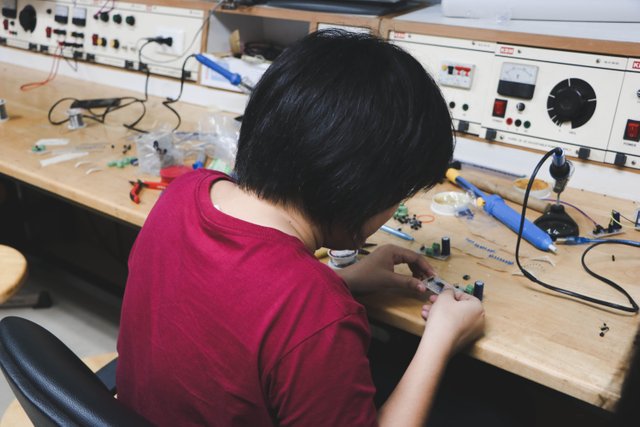HOW TO REPAIR AND SERVICING YOUR ELECTRONICS GADGETS PART 1
 Electronics is a wide and very interesting field of learning, equally useful to the professional as to the simple, curious mind. It is very handy in putting things right in the home instead of paying every time to have them done.
Electronics is a wide and very interesting field of learning, equally useful to the professional as to the simple, curious mind. It is very handy in putting things right in the home instead of paying every time to have them done.
Many of us have had the opportunity of studying fairly deep into electronics with its mathematical implications, only to find at a certain stage that something is still missing despite the certificates: The ability to locate a fault quickly when equipment has broken down and to put it right in the minimum of time.
Practical idea on electronics is essential today because of the growth of the industry in our society based on contemporary applications of electronics in the use of domestic and professional gadgets in our homes.
Many different electronic products are found within the consumer electronics field. Yesterday, the radio was king, and today we have several new electronic products, such as the TV, CR combo, CD, DVD, VCR combo, and MP3 players. Also new DVD player is combined with a DVD/CD, DVD/VCR, or DVD/VCR/CD changer, and on it goes.
Servicing consumer electronic product can be a lot of fun if you let it be. Just as in solving a great murder mystery, the smart detective must have the skill, desire, and ability to find the culprit, so also the electronics technician must take the symptom and isolate, locate, remove, and replace the defective part.
The anticipation of locating a dead, open, or leaky component is like finding a needle in a haystack, so to speak. Your heart beats a little faster as you zoom in on the suspected part. Then great disappointment sets in when the suspected component is not the guilty party. So you try once again.
In this write up, we are going to discourse about Radio Fault. To diagnose a fault in a radio, you need to know electronics components like Transistors, Capacitors, Diodes, Resistors, Integrated circuit, to mention a few, you need to have the following tools ready:
- Sol dine Iron
- Soldering led
- Multi meter
- Pliers
- Screwdrivers
- Working Table
- Workshop
- Power Supply
 Suppose now a customer or a boss says his radio tape is faulty. Our first concern is to find out whether the tape section is faulty or the radio side, or both.
Suppose now a customer or a boss says his radio tape is faulty. Our first concern is to find out whether the tape section is faulty or the radio side, or both.
In the first place, when the tape is faulty but the radio work, we can be sure the whole string of amplification and detection from the antenna to the speaker is good. The fault now lies with either:
A. The playback head of the tape which may be dirty or dead.
B. If it play back but does not record, then inspect record switch inside, not forgetting of course to check all wires to the record/playback head. Two wires for mono, four wires for stereo equipment. There is the possibility of a transistor or more, associated with the amplification of the recorded signal. Here a circuit diagram will be of help to find out which transistors. For heavy commercial equipment which are still old fashioned, Valves are used for such.
C. If the tape does not roll at all, then suspect either the power supply to the motor, the motor itself, or the rubber driving belt.
Suppose now the entire radio tape is dead; nothing turns and there is no sound! This is purely a power supply affair.
a. Is it the failure of the AC power supply through the power cable itself? Check if the cable is broken.
b. Is the AC supply arriving at the transformer but not getting to the rectifier? Switch on your test meter to a high AC range, first and test the for input. Then to the lower level AC and check at the secondary of the transformer, leading to the rectifiers, of course with the rectifier disconnected because they may be shorting.
c. Now that we have found low required AC on the secondary, how about disconnecting the rectifiers and seeing if DC comes out of them? Ah, now there is nothing. Please switch your meter to ohms range and text the rectifiers for unidirectional conductivity, meaning, text for high resistance in one direction and low resistance when you reverse the leads of the meter. This is the characteristic of all diodes that are semiconductors.
d. Suppose now there was no AC on the transformer. It is possible that someone had mistakenly switched to 110 volts instead of 220 volts used in the British Commonwealth countries especially France. Take a quick look at the main regulator. By the time you find out the mistake, the transformer is most probably blown open already. Cold continuity checks may be affected to confirm the dead of the transformer.
Where we find that rectifiers are gone, that is they have the same low resistance in both directions, we must also check around for any capacitor which may leak, or even any other decoupling capacitor on the DC line in the circuit further on. Capacitors are criminals in electronics circuits. They provoke more troubles for other component than the components themselves.
It is possible that the rectifiers are not yet dead but the DC voltage sinks when the filter capacitors or the rest of the circuit is reconnected to them. This is where you begin to suspect fault capacitor or a shorting semi conductors such as transistor drawing the potential to earth. Such a component is likely to be hot if you feel with your hand. When this condition has been reached, then you must unplug from the mains. The time for cold check strictly has come.
When checking the faulting capacitors, switch the meter to resistance range x100 for greater sensitivity. Capacitor that kicks and returns to a high resistance is good. If it doesn’t do this and it remains low, disconnect one leg of it from the set and re-test. If the resistance still remains low, change the capacitor.
Suppose now it is the tape that is good but the radio does not work? This mean the fault is between the aerial input and the volume control only. Since the tape output passes through the Audio stage and it is good, it means the Audio to the speaker is good. Before rushing into a wild goose-chase, it is important to remember that the food for every Electronic equipment is its electrical power. It is therefore advisable to check the collector voltages to the Mixer and I.F. Transistors. If the voltage is missing to one stage, it is enough to keep the radio quiet. Just think of something common to all the wavebands in the radio. If this goes wrong, you expect all the wavebands to be dead. Really, fault finding is a lot of logics and common sense. Apart from the failure of DC supply to say, the Mixer or the I.F, other components that may cause the radio chain to be dead are:
I. The tuning capacitor. It may be shorting at or from one point on wards in the variable track. No signal.
II. An I.F. coil that is open-circuited: An I.F. amp translator.
III. The diode Audio detector. Yes, this is very possible.
IV. The connection between the detector and the volume control pot.
There have been instances where only one waveband is faulty while other work. You will ask yourself: What are the components related to a waveband but not common to others? Here we have the R.F. coil of the band, the oscillator Coil for the band, the selector switch for the Coils since these are common to all bands and some other wave bands are working.
So far, it would seem I have been dealing with people a bit conversant with radio repair procedures. I now begin to think of the raw beginners who do not even know about the color code of resistors. It will also serve as a reminder or refresher to such people.
Congratulations @saintdaniel! You have completed the following achievement on the Steem blockchain and have been rewarded with new badge(s) :
You can view your badges on your Steem Board and compare to others on the Steem Ranking
If you no longer want to receive notifications, reply to this comment with the word
STOPVote for @Steemitboard as a witness to get one more award and increased upvotes!
This is good. Pls keep it up!
Very informative